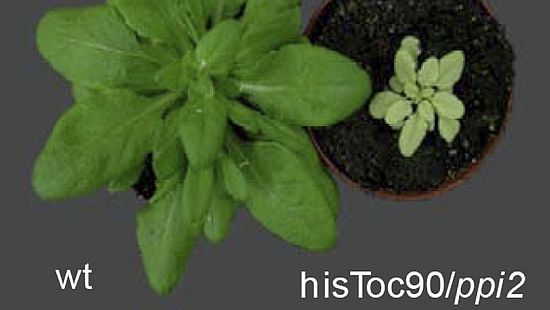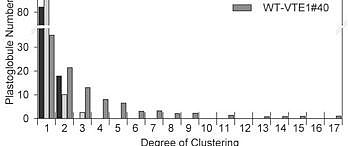Discovering how chloroplasts are made
The chloroplast is the site of photosynthesis in plants. Most of the chloroplast proteins must be imported from the cytosol. The plant physiology laboratory is interested in the import mechanism and over the years has identified and analyzed components of the chloroplast protein import machinery consisting of the translocon complexes at the outer (Toc) and inner (Tic) membranes. Many of the Toc and Tic components are essential for plant viability and have pale (eg Toc33), albino (eg Toc159) or embryo lethal (eg Toc75) phenotypes.
Chloroplasts contain lipid droplets called plastoglobules. They are involved in the lipid metabolism of the photosynthetic membrane system, the thylakoids. Plastoglobules are studded with enzymes involved in thylakoid lipid metabolism and play a role (among others) in the synthesis and accumulation of prenylquinones: tocopherol (Vitamine E), phylloquinone (Vitamine K) and plastoquinone. In the framework of the SPSW, we use mass spectrometry techniques to determine the lipidome of plastoglobules. Mass spectrometry is also an essential tool to discover the function of unknown plastoglobule enzymes by comparing the lipids in mutants to the wild type.
Publications
- A multifaceted analysis reveals two distinct phases of chloroplast biogenesis during de-etiolation in Arabidopsis
Pipitone, Rosa; Eicke, Simona; Pfister, Barbara; Glauser, Gaetan; Falconet, Denis; Uwizeye, Clarisse; Pralon, Thibaut; Zeeman, Samuel C; Kessler, Felix; Demarsy, Emilie
Elife e62709, 10.7554/eLife.62709, FEB 25 2021 - SUMOylation contributes to proteostasis of the chloroplast protein import receptor TOC159 during early development
Accossato, Sonia; Kessler, Felix; Shanmugabalaji, Venkatasalam
Elife 9, DEC 22 2020 - Mutation of the Atypical Kinase ABC1K3 Partially Rescues the PROTON GRADIENT REGULATION 6 Phenotype in Arabidopsis thaliana
Pralon, Thibaut; Collombat, Joy; Pipitone, Rosa; Ksas, Brigitte; Shanmugabalaji, Venkatasalam; et al.
Frontiers In Plant Science, 10.3389/fpls.2020.00337, MAR 25 2020 - Characterization of a Plastoglobule-Localized SOUL4 Heme-Binding Protein in Arabidopsis thaliana
Shanmugabalaji, Venkatasalam; Grimm, Bernhard; Kessler, Felix
Frontiers In Plant Science 11 Article Number: 2 DOI: 10.3389/fpls.2020.00002 JAN 31 2020 - PROTEIN HOMEOSTASIS How chloroplasts protect themselves from unfolded proteins
Kessler, Felix; Longoni, Paolo
ELIFE 8 Article Number: e51430 DOI: 10.7554/eLife.51430 OCT 15 2019 - Plastoquinone homoeostasis by Arabidopsis proton gradient regulation 6 is essential for photosynthetic efficiency
Pralon, Thibaut; Shanmugabalaji, Venkatasalam; Longoni, Paolo; Glauser, Gaetan; Ksas, Brigitte; Collombat, Joy; Desmeules, Saskia; Havaux, Michel; Finazzi, Giovanni; Kessler, Felix
COMMUNICATIONS BIOLOGY 2 Article Number: 220 DOI: 10.1038/s42003-019-0477-4 JUN 2019 - CHLORAD: Eradicating Translocon Components from the Outer Membrane of the Chloroplast
Shanmugabalaji, V; Kessler, F
MOLECULAR PLANT, 12 (4):467-469; 10.1016/j.molp.2019.03.002 APR 1 2019 - Affinity Purification of Chloroplast Translocon Protein Complexes Using the TAP Tag
Shanmugabalaji, V; Douet, V; Agne, B; Kessler, F
JOVE-JOURNAL OF VISUALIZED EXPERIMENTS, (141):10.3791/58532 NOV 2018 - Plastidial NAD-Dependent Malate Dehydrogenase: A Moonlighting Protein Involved in Early Chloroplast Development through Its Interaction with an FtsH12-FtsHi Protease Complex
Schreier, Tina B.; Clery, Antoine; Schlaefli, Michael; Galbier, Florian; Stadler, Martha; Demarsy, E; Albertini, D; Maier, BA; Kessler, F; Hortensteiner, S; Zeeman, SC; Kotting, O
PLANT CELL 30 (8):1745-1769 10.1105/tpc.18.00121 AUG 2018 - Chloroplast Biogenesis Controlled by DELLA-TOC159 Interaction in Early Plant Development
Shanmugabalaji, V; Chahtane, H; Accossato, S; Rahire, M; Gouzerh, G; Lopez-Molina, L; Kessler, F
CURRENT BIOLOGY, 28 (16):2616-+; 10.1016/j.cub.2018.06.006 AUG 20 2018 - Essential role for phytol kinase and tocopherol in tolerance to combined light and temperature stress in tomato
Spicher, Livia; Almeida, Juliana; Gutbrod, Katharina; et al.
JOURNAL OF EXPERIMENTAL BOTANY, 68 (21-22): 5845-5856 10.1093/jxb/erx356 2017

Prof. Dr. Felix Kessler
University of Neuchâtel
Institute of Biology
2000 Neuchâtel
Tel: +41 (0)32 718 22 92
Links
Research topics
- Chloroplast Biogenesis
- Chloroplast Protein Import
- Chloroplast Lipid Droplets
Interdisciplinary
- Analytical chemistry of natural products
- Systems Biology


